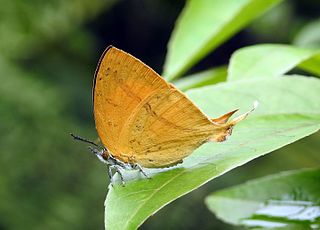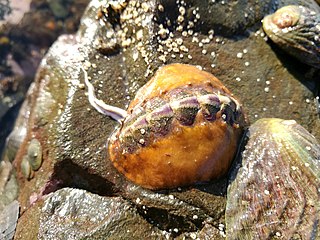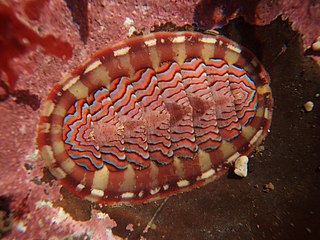
Chitons are marine molluscs of varying size in the class Polyplacophora, formerly known as Amphineura. About 940 extant and 430 fossil species are recognized.

The large tortoiseshell or blackleg tortoiseshell is a butterfly of the family Nymphalidae.

The gumboot chiton, also known as the giant western fiery chiton or giant Pacific chiton, is the largest of the chitons, growing to 36 cm (14 in) and capable of reaching a weight of more than 2 kg (4.4 lb). It is found along the shores of the northern Pacific Ocean from Central California to Alaska, across the Aleutian Islands to the Kamchatka Peninsula and south to Japan. It inhabits the lower intertidal and subtidal zones of rocky coastlines. The gumboot chiton's appearance has led some tidepoolers to refer to it, fondly, as the "wandering meatloaf". The name "gumboot chiton" seems to derive from a resemblance to part of a rubber Wellington boot or "gum rubber" boot.

Lampides boeticus, the pea blue, or long-tailed blue, is a small butterfly that belongs to the lycaenids or gossamer-winged family.

Loxura atymnus, the yamfly, is a species of lycaenid or blue butterfly found in Asia.

Chiton glaucus, common name the green chiton or the blue green chiton, is a species of chiton, a marine polyplacophoran mollusk in the family Chitonidae, the typical chitons. It is the most common chiton species in New Zealand. Chiton glaucus is part of a very primitive group of mollusc with evidence of being present in up to 80 million years of the fossil record.

Cryptoconchus is a genus of chitons in the family Acanthochitonidae.

Ischnochiton maorianus, sometimes called the variable chiton, is a fast moving species of chiton in the family Ischnochitonidae, endemic to the main islands of New Zealand where it is abundant.

Notoplax violacea is a species of chiton in the family Acanthochitonidae, endemic to all coasts of New Zealand, where it is common in northern areas.

Tonicella lineata, commonly known as the lined chiton, is a species of chiton from the North Pacific.

Mopalia spectabilis, commonly known as the red-flecked mopalia, is a species of chiton.

Tonicella lokii, commonly known as the flame lined chiton or Loki's chiton, is a chiton in the lined chiton genus Tonicella.

Mopalia muscosa, the mossy chiton, is a species of chiton, a polyplacophoran, an eight-plated marine mollusk. It is a northeastern Pacific species which occurs from British Columbia, Canada, to Baja California Mexico.
Chaetopleura pertusa, the orange hairy chiton, is a species of chitons in the family Chaetopleuridae. It is a marine mollusc. It is endemic to South Africa.

Mopalia ciliata is a chiton in the genus Mopalia, commonly known as the hairy chiton. It is a medium-sized marine mollusc up to 5.0 cm (2.0 in) in length. It is oval shaped with 8 separate, moderately elevated, overlapping ridged valves on its dorsal surface. Hairy chitons can be found along the coast of North America.

Chiton olivaceus, the green chiton, is a species of chiton, a marine polyplacophoran mollusk in the family Chitonidae, the typical chitons.

Plaxiphora obtecta is a large chiton in the family Mopaliidae, endemic to New Zealand, where it is most often found on the West Coast of the North Island. It is called Haka-hiwihiwi by some Māori and was likely a food source.

Astrostole scabra, commonly called the seven-armed starfish, is a sea star in the family Asteriidae, native to New Zealand, eastern Australia and southern Australia. A frequent inhabitant of the intertidal zone also seen attached to wharf piles, it is among the larger sea-stars found in New Zealand. Adults often prey on mussels, forcing the shells open by applying pressure for long periods with the tube feet.

Acanthochitona crinita is a species of marine chiton in the family Acanthochitonidae. It is found on rocky coasts in the northeastern Atlantic Ocean, the North Sea and the Mediterranean Sea.

Tonicella marmorea is a species of chiton, a polyplacophoran mollusc found in the Arctic Ocean and the North Atlantic Ocean. It was first described by the Danish missionary and naturalist Otto Fabricius.



















